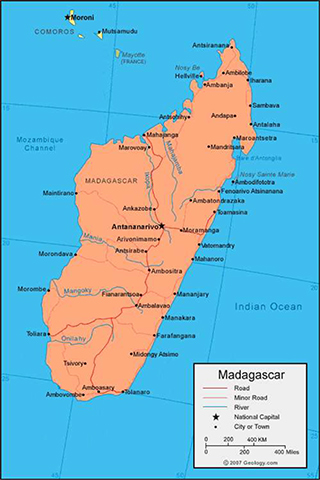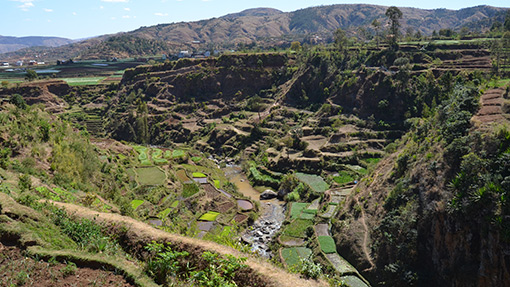The Fiangonana Loterana Malagasy (FLM):
The History of One of the Fastest-Growing Lutheran Churches in the World
Introduction

Madagascar
According to an agreement with the London Missionary Society (LMS), which started mission work in Madagascar in 1818, and the Norwegian Mission Society (NMS), which began work in 1866, the two mission societies divided the country of Madagascar between them. The LMS had the northern half of the island, while the NMS had the south. After a few decades of mission work in Madagascar, the NMS in 1888 contacted Lutheran Christians in America of Norwegian descent, the United Norwegian Lutheran Church, and invited them to join in the mission work. They were given the assignment to be responsible for mission work in the southern part of Madagascar. The American Lutheran Free Church joined the mission work in 1894.

Madagascar – global view
The dates of the arrival of different Missions show that interest in Madagascar at the time was great:
- 1818 London Missionary Society
- 1861 Jesuits
- 1864 Society for the Propagation of the Gospel
- 1864 Church Missionary Society
- 1866 Norwegian Mission Society (Lutheran)
- 1867 Friends’ Mission (Quakers)
- 1888 United Norwegian Lutheran Church
- 1894 The Lutheran Free Church
- 1896 French Protestant Mission
Norwegian Mission Society – 1866
The Norwegian Mission Society was started by a group of approximately 180 people in the town of Stavanger in Norway in August of 1842. The goal was to bring the Gospel of Jesus Christ to other peoples, mainly in Africa. John Engh and Niels Nilsen were the first missionaries sent by the Norwegian Missionary Society. They arrived in Madagascar (Antananarivo) in 1866. They were not having much success in getting people to listen to the Christian message around Antananarivo, so they decided to travel through the South Central region of the island near a town called Betafo (near Antsirabe).
The king of that region was very sick. He had sought out healing from many native healers, but no one was able to help him. When these two Norwegian missionaries came through the area, they asked the king for permission to share the Gospel message with his people. He was reluctant. The missionaries learned of his physical ailments and gave him some medicine that cured his illness. This resulted in the king inviting the missionaries to come and share the Gospel and build a church any place they desired. Thus, the first Lutheran Church in Madagascar was located at Betafo.

Malagasy Lutheran Church at Betafo

Fields near Betafo
Arrival of American Lutherans of Norwegian Descent
The Norwegian Mission Society invited the American United Norwegian Lutheran Church to join in the mission work in 1888. They were assigned to work in the southern part of Madagascar. When the American Lutheran Free Church joined the work in 1894, the United Norwegian Lutheran Church divided the southern area of Madagascar into two areas. The United Norwegian Lutheran Church would work in the southeast, centered around Fort-Dauphin (now called Taolagnaro) and the Lutheran Free Church would work in the southwest, centered around Tuléar (now called Toliara).

Oline & John Hogstad
Rev. John and Mrs. Oline Hogstad
- The first Norwegian American missionary to Madagascar
- Graduate of Augsburg Seminary
- Arrived in Madagascar in 1888
- Ordained at Hawk Creek Lutheran Church near Sacred Heart, Minnesota

Missionaries in Madagascar, 1907 Back (l-r): Martha Stolee, Wilhelm Trygstad (served 1905-1951), Martha Trygstad, Johan P. Hogstad (served 1887-1911), Lena Hogstad, Lucretia Bjelde Front (l-r): M.J. Stolee (served 1900-1909), Sr. Caroline Thompson (served 1907-1917), Nellie Dahl (served 1905-1942), Sr. Mette Hagen (served 1907-1947) and Peter A. Bjeld (served 1905-1943)
Preparing Malagasy People to Lead the Mission Work
In 1871, only a few years after the first American Norwegian missionaries arrived in Madagascar, they established a seminary in the capital city of Antananarivo, led by missionary Lars Dahle. A few years later, the theological seminary moved to Fianarantsoa, approximately 500 km south of the Antananarivo. The first students graduated in 1876, and the first Malagasy pastors were ordained in 1883. The missionaries knew that they were in Madagascar to preach the Gospel, prepare the Malagasy Christians to become the leaders for the church, and then help them organize the future indigenous Malagasy Lutheran Church.

Madagascar pastors in 1910s Front (l-r): Johan Fjeldstad (served 1910-1915), Strum, Daniel Belanitra, Rabenjaimina, Ragnvald, Rajonary, Peter A. Bjeld (served 1905-1943) Back (l-r): Daniel Hoyme, Christian Pedersen (served 1908-1948), Alfred Picard (served 1908-1914, 1919-1926), Wilhelm Trygstad (served 1905-1951), Gunnerius Torvik (served 1901-1945), Rotinea, Peter C. Halvorson (served 1897-1916)
The Formation of the Malagasy Lutheran Church, 1950
The First Lutheran Mission Field to Establish an Autonomous National Church Organization
Malagasy
noun: word forms: plural -gasy or –gasies “a native or inhabitant of Madagascar” or “the official language of Madagascar belonging to the Malayo-Polynesian family.”
Adjective: “of or relating to Madagascar, its people, or their language”
— Collins Dictionary.com
November 1950 marked the most significant milestone in the history of Malagasy Lutheranism, and the beginning of the FLM, or Fiangonana Loterana Malagasy. The idea was to begin the process of making the Lutheran church in Madagascar a wholly Malagasy institution, devoid of direct international influence. Almost a decade after the formation of the FLM, at the September 1961 general meeting of the synods at Tulear (now called Toliara), the FLM voted and passed a complete severing from foreign church authorities and elected their first president, Docteur Rakoto Andrianarijaona.
After almost an entire century, the Lutheran church was officially “Malagasy” in administration and governance. This move to independence was complemented by a drastic increase in evangelization efforts, and over the course of the second half of the 1960s, Lutheran membership increased by 67% within Madagascar.
At its founding, the Malagasy Lutheran Church had around 18,000 members; today it has more than 4 million members and is the 9th largest church in the Lutheran World Federation (LWF). It was the first former “mission field” church to become an autonomous church body and to be accepted into the Lutheran World Federation.
Reason for Growth
Evangelism is the Driving Force of the Church
The reason for the rapid growth is that the Malagasy Lutheran Church leaders adopted their own indigenous evangelism method, called The Fifohazana Movement. It is a revival movement, focused on the Word of God, which has been incorporated into the mission and ministry of the Malagasy Lutheran Church. The movement was started by a Christian convert called Dada Rainisoalambo in 1894.
It trains laypersons, called mpiandry (shepherds), to proselytize and minister to non-Christians and to Christians who continue to practice the traditional Malagasy religion. Throughout Madagascar, the movement has established compounds, called toby, where church activities, exorcism (order of confession to drive out evil from one’s life), counseling, caring for the elderly and mentally ill, and medical care are carried out.
This movement has the best understanding of how Christians should balance teaching and living the Christian Faith and living out social justice in society. Most leaders in the Malagasy Lutheran Church have been trained in the Fifohazana Movement.
Thankful for American Missionaries
From 1888 through 2010, there were 366 American Missionaries who served in Madagascar. This equals 5,445 years of individual missionary service to help establish the dynamic Malagasy Lutheran Church. The average time of service for a missionary was 14.88 years. The longest term that a missionary served in Madagascar was 46 years.

American Missionaries and Families in 1993
Near the end of the 20th century, the foreign missionary community was dwindling quickly. There was a changing role regarding who was doing the mission work in Madagascar. The Malagasy Lutheran Church, built upon the foundation that the missionaries developed, are now able to provide all of the leaders, evangelists, teachers and pastors that the church needs for its work and continuing growth. Christians are welcome to serve in the Malagasy Lutheran Church, as they are in any church across the world, but the mission is not dependent upon them.
A Vibrant and Growing Church
The Malagasy Lutheran Church is all about evangelism. They live out the faith in sharing the Good News of the Gospel of Jesus Christ in evangelistic outreach and translate it into how they serve people’s physical needs as the Gospel in action! Social work, development and evangelism are held together by the FLM and together constitute its witness in society.
The church continues and expands the work that was started by the pioneer missionaries. It runs seven hospitals and 25 dispensaries throughout the country, two leprosy hospitals, and schools for the deaf and the visually impaired. Eighty percent of the population of Madagascar are peasants. The development work of the FLM is an important means to reach the people in their daily life and bring them to Jesus. The church has three large farm schools, and a training program for peasants aimed at promoting agriculture and animal husbandry. It runs many primary and secondary schools, and is developing a Lutheran university in the southern part of the island.
The FLM is organized into 25 regional synods. The national synod is the body that holds the work of the church together. The national synod committee meets every four years and has the authority to decide on all matters related to worship and the spiritual life of the church, the administration, the departments and associations, and the mission of preaching and announcing the Gospel that is carried out by the church. The executive board implements the decisions, under the leadership of the president and the general secretary who both work full-time at the national office.
Currently there are 5,000 congregations, 1,200 pastors, and 25 synods in the Malagasy Lutheran Church.

Evangelism team traveling to a neighboring village to share the message of the Gospel

Evangelist (on left) and believers holding worship in their new church building

Men in the Prison Ministry Program being confirmed in one of the prisons
The Greatest Needs
Madagascar always ranks in the top ten poorest nations in the world. The colonial occupation of the French for 75 years was devastating to the country. France took the wealth out of the country and did not help Madagascar develop an economy. The pattern continues today. Even though they are an independent country, old habits continue to control the economy. So the lack of wealth in the country also affects the ability of the church to support its mission and ministry. In addition, the main line churches in Europe and the USA have significantly decreased their financial mission support.
This is the ebb and flow of mission down through the centuries. Small mission organizations are replaced through consolidation into large national church organizations and then back again to smaller nonprofits. Today we see the creation of many small nonprofits, who are picking up the support for mission.
Into this mission situation, an 11-year-old nonprofit organization, Friends of Madagascar Mission (FOMM), was created to provide financial and prayer support for mission and ministry in Madagascar. FOMM does not run any programs, but supports programs with prayer and financial support.
Currently they are supporting these programs:
- Evangelists
- Prison Ministry
- Ejeda Nutrition Program and Emergency Medical and Food Programs
- Bible Schools
- Tandroy Bible Printing Project
- Drip Irrigation Program
- Nofy i Androy Program (girls’ education)
- Center for the Education of the Visually Impaired
- Numerous other one-time projects
Support Mission in Madagascar
For more information on how you may support mission in Madagascar go to:
Want more info?
- Email the author.
- Like this article? Share it using the social media buttons below.
- Want a print copy? Click the printer icon below.
- And please rate the article!






